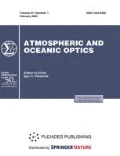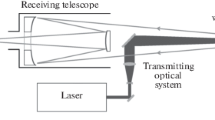Abstract
We present experimental results on the remote detection of surface traces of some high-energy materials using a Raman lidar designed on the basis of an excimer KrF laser with a narrow generation line and a multichannel spectrum analyzer based on diffraction a spectrograph and time-gated ICCD camera. The sensitivity of the system is evaluated for a detection range of 10 m. A detection limit is attained for the traces of nitrogen-containing chemical materials with a surface density of 0.5 μg/cm2 at a signal accumulation of over 1000 laser pulses.
Similar content being viewed by others
References
S. M. Bobrovnikov, A. B. Vorozhtsov, E. V. Gorlov, V. I. Zharkov, E. M. Maksimov, Y. N. Panchenko, and G. V. Sakovich, “Lidar detection of explosive vapors in the atmosphere,” Russ. Phys. J. 58 (9), 1217–1225 (2016).
C. M. Wynn, S. Palmacci, R. R. Kunz, and M. Rothschild, “Noncontact detection of homemade explosive constituents via photodissociation followed by laserinduced fluorescence,” Opt. Express 18 (6), 5399–5406 (2010).
T. Arusi-Parpar, D. Heflinger, and R. Lavi, “Photodissociation followed by laser-induced fluorescence at atmospheric pressure and 20°C: A unique scheme for remote detection of explosives,” Appl. Opt. 40 (36), 6677–6681 (2001).
L. A. Skvortsov, Laser Techniques for the Remote Detection of Chemical Compounds on Body’s Surface (Tekhnosfera, Moscow, 2014) [in Russian].
B. G. Ageev, A. V. Klimkin, A. N. Kuryak, K. Yu. Osipov, and Yu. N. Ponomarev, “Remote detector of hazardous substances based on a tunable 13C16O2 laser,” Atmos. Ocean. Opt. 30 (3), 204–208 (2017).
B. C. Dionne, D. P. Rounbehler, E. K. Achter, J. R. Hobbs, and D. H. Fine, “Vapor pressure of explosives,” J. Energetic Mater. 4 (1), 447–472 (1986).
G. L. Gresham, J. P. Davies, L. D. Goodrich, L. G. Blackwood, B. Y. H. Liu, D. Thimsen, S. H. Yoo, and S. F. Hallowell, “Development of particle standards for testing detection systems: Mass of RDX and particle size distribution of composition 4 residues,” Proc. SPIE 2276, 34–44 (1994).
R. Chirico, S. Almaviva, F. Colao, L. Fiorani, M. Nuvoli, D. Murra, I. Menicucci, F. Angelini, and A. Palucci, “Proximal detection of traces of energetic materials with an eye-safe UV Raman prototype developed for civil applications,” Sensors 16 (1), 1–18 (2016).
S. Bobrovnikov, E. Gorlov, and V. Zharkov, “Simulation of the Raman lidar signal for localized source of atmospheric pollution,” Proc. SPIE 9292, 9292–48 (2014).
M. D. Ray and A. J. Sedlacek, “Ultraviolet mini- Raman lidar for stand-off, in-situ identification of chemical surface contaminants,” Rev. Sci. Inst. 71 (9), 3485–3489 (2000).
J. S. Arthur, D. R. Mark, N. S. Higdon, and D. A. Richter, “Short-range, non-contact detection of surface contamination using Raman lidar,” Proc. SPIE 4577, 95–104 (2001).
GOST 31581-2012 “Laser Safety. General Safety Requirements during the Design and Use of Laser Devices” (Standartinform, Moscow, 2013) [ in Russian].
American National Standard for safe use of lasers ANSI 136.1-2000 (Laser Institute of America, 2000).
S. M. Bobrovnikov, E. V. Gorlov, V. I. Zharkov, “Experimental estimation of the sensitivity of the UV Raman lidar,” Atmos. Ocean. Opt. 26 (4), 320–325 (2013).
J. C. Carter, S. M. Angel, M. Lawrence-Snyder, J. Scaffidi, R. E. Whipple, and J. G. Reynolds, “Standoff detection of high explosive materials at 50 meters in ambient light conditions using a small Raman instrument,” Appl. Spectrosc. 59 (6), 769–775 (2005).
P. Jander and R. Noll, “Automated detection of fingerprint traces of high explosives using ultraviolet Raman spectroscopy,” Appl. Spectrosc. 63 (5), 559–563 (2009).
J. Moros, J. A. Lorenzo, K. Novotny, and J. J. Laserna, “Fundamentals of stand-off Raman scattering spectroscopy for explosive fingerprinting,” J. Raman Spectrosc. 44 (1), 121–130 (2013).
A. Pettersson, I. Johansson, S. Wallin, M. Nordberg, and H. Ostmark, “Near real time standoff detection of explosives in a realistic outdoor environment at 55 m distance,” Propellants, Explos., Pyrotech. 34 (4), 297–306 (2009).
A. Pettersson, S. Wallin, H. Ostmark, A. Ehlerding, I. Johansson, M. Nordberg, H. Ellis, and A. Al-Khalili, “Explosives standoff detection using Raman spectroscopy: From bulk towards trace detection,” Proc. SPIE 7664, 76641 (2010).
R. Forest, F. Babin, D. Gay, N. Ho, O. Pancrati, S. Deblois, S. Desilets, and J. Maheux, “Use of a spectroscopic lidar for standoff explosives detection through Raman spectra,” Proc. SPIE 8358, 83580 (2012).
Y. N. Panchenko, M. V. Andreev, V. V. Dudarev, N. G. Ivanov, A. V. Pavlinskii, A. V. Puchikin, S. M. Bobrovnikov, E. V. Gorlov, V. I. Zharkov, and V. F. Losev, “Narrow-band tunable laser for a lidar facility,” Russ. Phys. J. 55 (6), 609–615 (2012).
T. Seuthe, M. Grehn, A. Mermillod-Blondin, H. J. Eichler, J. Bonse, and M. Eberstein, “Structural modifications of binary lithium silicate glasses upon femtosecond laser pulse irradiation probed by micro- Raman spectroscopy,” Opt. Mater. Express 3 (6), 755–764 (2013).
M. Gaft and L. Nagli, “UV gated Raman spectroscopy for standoff detection of explosives,” Opt. Mater. 30 (11), 1739–1746 (2008).
Laser Monitoring of the Atmosphere, Ed. by E.D. Hinkley (Springer, Berlin; Heidelberg; New York, 1976).
Author information
Authors and Affiliations
Corresponding author
Additional information
Original Russian Text © S.M. Bobrovnikov, E.V. Gorlov, V.I. Zharkov, 2017, published in Optika Atmosfery i Okeana.
Rights and permissions
About this article
Cite this article
Bobrovnikov, S.M., Gorlov, E.V. & Zharkov, V.I. Remote detection of traces of high-energy materials on an ideal substrate using the Raman effect. Atmos Ocean Opt 30, 604–608 (2017). https://doi.org/10.1134/S1024856017060057
Received:
Published:
Issue Date:
DOI: https://doi.org/10.1134/S1024856017060057




